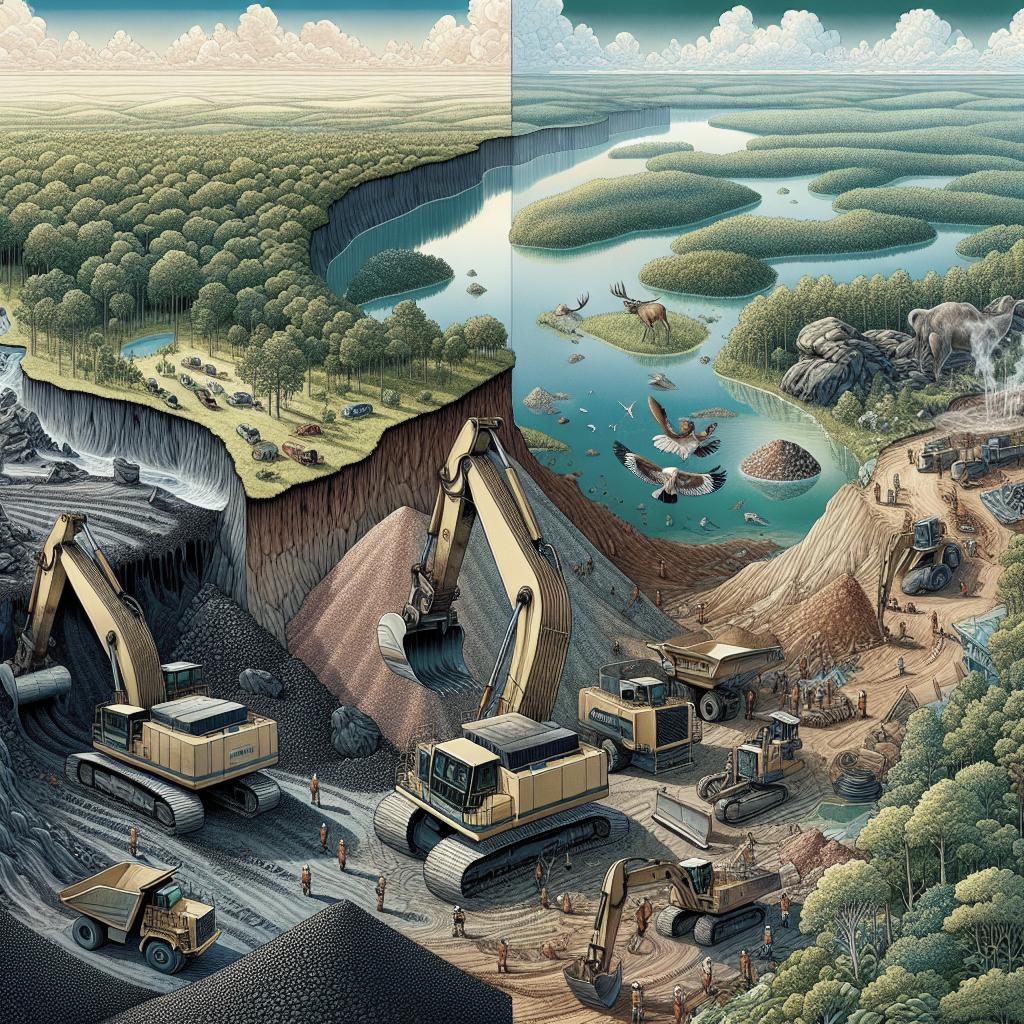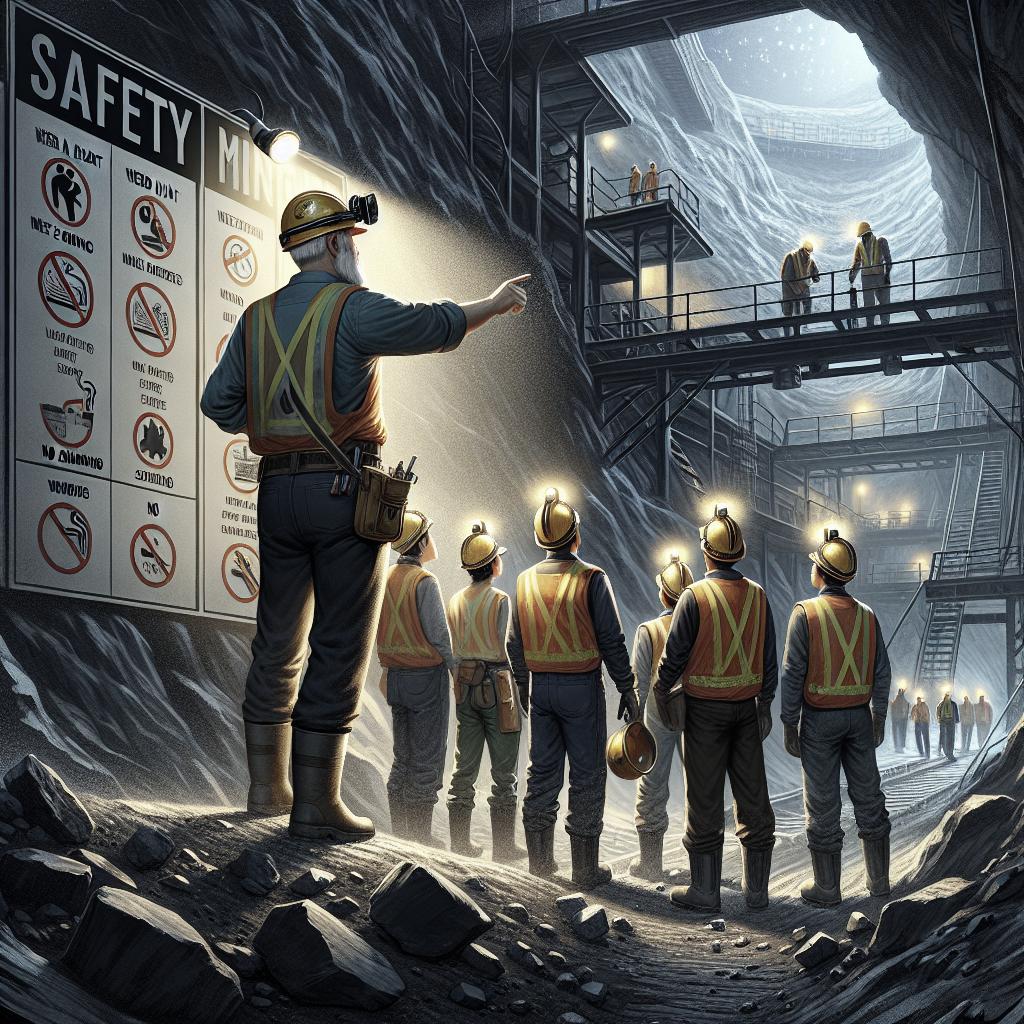<>
“`
Mining activities worldwide have resulted in significant alterations to the Earth’s landscape and have caused varying degrees of environmental damage. This blog post explores the multifaceted impacts of mining, from land degradation to water pollution, biodiversity loss, and air quality issues. The post covers the direct and indirect consequences of mining operations, providing a comprehensive understanding of how these activities influence our planet. It also addresses the social aspects, looking at how communities are affected and the importance of regulatory frameworks. Finally, we consider future prospects and potential strategies for minimizing the environmental impact of mining.
Share this news article on:
Mining is a significant economic activity that supports various industries but often leads to serious environmental consequences. Let’s delve into these impacts in detail.
Land Degradation
Mining activities, especially open-pit and strip mining, significantly alter the landscape, leading to deforestation, soil erosion, and loss of arable land. These activities strip away vast areas of vegetation, which can cause soil instability, making the land more vulnerable to erosion. Moreover, the removal of topsoil disrupts the natural nutrient cycle, leaving the soil less fertile and affecting local agriculture.
In addition, the large-scale excavation and disposal of overburden (the soil and rock removed to access ore deposits) result in massive spoil heaps that degrade the surrounding land. These heaps can lead to further erosion and land subsidence, making the landscape uneven and less amenable to reclamation efforts.
Water Pollution
One of the critical environmental issues associated with mining is water pollution. The extraction process often involves the use of chemicals like cyanide and sulfuric acid, which can leach into local water systems. This contamination affects not only the aquatic life but also the communities dependent on these water sources for drinking, agriculture, and fishing.
Moreover, mining activities often lead to the phenomenon known as “acid mine drainage”. When sulfide minerals are exposed to air and water, they undergo chemical reactions that produce sulfuric acid, which can seep into rivers, lakes, and groundwater, drastically lowering the water pH levels and leading to the destruction of aquatic habitats.
Biodiversity Loss
The mining industry’s encroachment into forests and other natural habitats leads to significant biodiversity loss. The removal of vegetation impacts the local flora and fauna, some of which might be endangered species. Habitat fragmentation occurs as mining operations create barriers that isolate wildlife populations, making it difficult for them to migrate, find mates, and access resources.
Furthermore, the noise and light pollution from mining sites disturb the natural behaviors of animals, including feeding, mating, and migration patterns. Species sensitive to these disturbances may either move away, reducing biodiversity in the area, or face a higher risk of mortality.
Air Quality Issues
Mining operations contribute significantly to air pollution through the release of dust and the emission of greenhouse gases. The dust generated from blasting, drilling, crushing, and transportation activities can contain harmful substances such as silica and heavy metals, posing health risks to both mine workers and nearby communities. Prolonged exposure to these particles can lead to respiratory diseases, including silicosis and lung cancer.
Furthermore, the use of heavy machinery and the combustion of fossil fuels associated with mining activities contribute to the emission of carbon dioxide (CO 2 ) and other greenhouse gases. These emissions not only exacerbate global warming but also lead to local air quality degradation, affecting both human health and the environment.
Effects on Local Communities
Aside from environmental damage, mining operations can also have profound social impacts. Communities living near mining sites often face displacement, loss of livelihoods, and a decline in their quality of life. Traditional lifestyles are disrupted as lands used for agriculture or cultural purposes are appropriated for mining activities. This leads to economic and social instability within these communities.
Moreover, the influx of workers can strain local infrastructure and services, such as schools, hospitals, and housing. Public health is also at risk due to increased exposure to pollutants and the potential for accidents and disasters associated with mining operations. Effective regulatory frameworks and community involvement are therefore crucial in mitigating these social impacts.
Regulatory Frameworks and Rehabilitation
To minimize the environmental impacts of mining, robust regulatory frameworks are essential. Governments should enforce strict environmental standards and conduct regular inspections to ensure compliance. This includes assessing sites for potential environmental damage before granting mining licenses and holding companies accountable for remediation efforts.
Rehabilitation is a critical aspect of managing mining’s environmental footprint. This involves restoring mined areas to their natural or economically usable state, which can include reforestation, soil remediation, and the construction of sustainable landforms. Companies are increasingly expected to adopt sustainable mining practices that prioritize the long-term well-being of the environment.
Future Prospects
As awareness about the environmental impacts of mining grows, future prospects hinge on the development and adoption of sustainable practices. Innovations in mining technology, such as remote sensing and automated machinery, can reduce the environmental footprint by improving efficiency and minimizing waste. Additionally, recycling and circular economy initiatives can reduce the demand for virgin materials, thereby decreasing the need for new mining operations.
International cooperation and stricter regulations are also vital. By working together, countries and organizations can establish global standards for environmental protection in mining. Investments in research and development of eco-friendly technologies can pave the way for a more sustainable future, ensuring that mining practices do not come at the expense of the planet’s health.
| Aspect | Impact | Potential Solutions |
|---|---|---|
| Land Degradation | Deforestation, soil erosion, loss of arable land | Reforestation, soil remediation, sustainable land use practices |
| Water Pollution | Chemical contamination, acid mine drainage | Proper waste management, treatment facilities, stringent regulations |
| Biodiversity Loss | Habitat destruction, species displacement | Protected areas, habitat restoration, wildlife corridors |
| Air Quality Issues | Dust, greenhouse gas emissions | Dust control measures, low-emission technologies, regulations |
| Local Communities | Displacement, livelihood loss, health risks | Community engagement, fair compensation, improved healthcare |
| Regulatory Frameworks | Compliance with environmental standards | Strict enforcement, regular inspections, accountability measures |
Related Links
- Understanding the Environmental Impact of Mining
- Mining and Water Pollution: A Global Issue
- How Mining Contributes to Biodiversity Loss
Related Topics
Related Articles
“`


